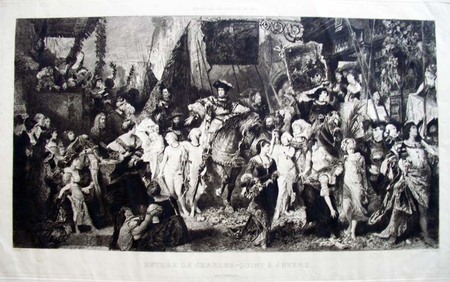From the Middle Ages through the Renaissance, coronations, marriages, and other royal occasions were celebrated with a triumphal entry or parade into the city. According to Les fêtes de la Renaissance (Firestone GT3930 .J16), Charles V (1500-1558) held no less than five triumphal entries in 1529, 1533, 1536, 1542, and 1548 during the Habsburg consolidation.
In a 1525 entry in his diary, Albrecht Dürer (1471-1528) commented on one of Charles V’s entry marches and (rough translation) how the king was received with a costly triumph, how there was music and great rejoicing, and beautiful young maidens, whose like I have never seen. 350 years later, Austrian artist Hans Makart not only painted the maidens accompanying Charles V “clothed in little more than pearls,” but also included Dürer in the crowd.
Makart’s architectural fantasies are often compared with the operas of Richard Wagner, because of the artists’ shared belief in a Gesamtkunstwerk or total work of art. Makart’s painting was reproduced in various printed forms throughout Europe and the United States. The naked women led to censorship of the image through the Comstock Act and assured its widespread popularity in America.
Adolphe Lalauze (1838-1905) after a painting by Hans Makart (1840-1884), Entrée de Charles-Quint à Anvers (Entry of Charles V into Antwerp), ca. 1878. Etching with aquatint. French Print collection GC077.
